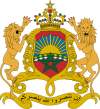- Spanish Protectorate of Morocco
-
Spanish protectorate of Morocco
حماية إسبانيا في المغرب
Protectorado español de MarruecosProtectorate of Spain ← 
←
←
←
1913–1956  →
→
 →
→
 →
→
 →
→Map of the northernmost territories belonging to the Spanish Protectorate of Morocco (1912–56) Capital Tétouan Language(s) Arabic, Spanish Religion Islam, Catholicism Political structure Protectorate High Commissioners - 1913 Felipe Alfau y Mendoza - 1951-56 Rafael García Valiño Historical era Interwar period - Treaty of Fez March 30, 1912 - Established February 27, 1913 - Independence April 7, 1956 Currency Spanish peseta The Spanish protectorate of Morocco (Arabic: حماية إسبانيا في المغرب; Spanish: Protectorado español de Marruecos) was the area of Morocco under colonial rule by the Spanish Empire, established by the Treaty of Fez in 1912 and ending in 1956, when both France and Spain recognized Moroccan independence.
Contents
Territorial borders
The territories of the Spanish protectorate of Morocco included northern Morocco (except Ceuta and Melilla, which have been Spanish since the 16th and 15th century, respectively), and the Cape Juby or Tarfaya Strip in the extreme South. On the contrary, the small territory of Ifni, being of Spanish sovereignty, was not a part of the Spanish protectorate.
The capital of Spanish protectorate of Morocco was Tetuán (Tétouan).
The rest of the country was ruled by France, under the name of French Morocco, also from 1912 to 1956.
The city of Tangier was declared an international zone, though this status was suspended during World War II when it was provisionally occupied by Spanish troops, from 14 June 1940, on the pretext that an Italian invasion was imminent.[1]
The Republic of the Rif led by the guerrilla leader Abd El-Krim was a breakaway state that existed in the Rif region from 1921 to 1926, when it was dissolved by joint expedition of the Spanish Army of Africa and French forces during the Rif War.
Spanish enclaves in northern Morocco
Ceuta had been Portuguese since 1415 before becoming Spanish in 1640. Melilla had been part of Spain since 1497, neither was included formally in the Protectorate, but were ruled with the same provisions as in the rest of the Spanish mainland territory. As for the plazas de soberanía (Spanish name for various enclaves and islands on the northern Moroccan coast), they were gained in 16th–19th centuries, before the international agreements on the Protectorate.
History
The Protectorate system was established in 1912. The legal Islamic qadis system was formally maintained.
The Moroccan Sephardi Jews—many of them living in this part of the Maghreb after being expelled from Spain and Portugal in 1492 and 1497 respectively after the end of the Reconquista process—flourished in commerce, profiting from the similarity of Spanish and Ladino language and benefiting from the tax-exempt area in Tangier and a flourishing trading activity in the area.
The Spanish Civil War started in 1936 with the uprising of the Spanish troops stationed in África (as the Protectorate was informally known in the Spanish military parlance) under the command of Francisco Franco against the Republican Government. These troops became the core of the Nationalist Army, which also recruited a considerable number of Moroccan troops.
The communist parties, the Communist Party of Spain and Workers' Party of Marxist Unification (POUM), advocated anti-colonialist policies whereby the Republican Government would support the independence of Spanish Morocco, intending to create a rebellion in Franco's back and cause disaffection among his Moroccan troops. However, the Republican Government under the Spanish Socialist Workers' Party (PSOE) rejected any such idea - which would have likely resulted in conflict with France, the colonial ruler of the other portion of Morocco.[2]
Because the local Muslim troops had been among Franco's earliest supporters, the protectorate enjoyed more political freedom than Franco-era Spain proper after Franco's victory,[3] with competing political parties and a Moroccan nationalist press, criticizing the Spanish government.
In 1956, when French Morocco became independent, Spain discontinued the Protectorate and surrendered the territory to the newly independent kingdom while retaining the plazas de soberanía, Ifni and other colonies outside Morocco, such as Spanish Sahara.
Unwilling to accept this, the Moroccan Army of Liberation waged war against the Spanish forces and in the Ifni War of 1958, spreading from Sidi Ifni to Rio de Oro, gained Tarfaya. In 1969, Morocco obtained Ifni. Morocco claims Ceuta and Melilla as integral parts of the country, considering them to be under foreign occupation, comparing their status to that of Gibraltar.
See also
- List of colonial heads of Spanish Morocco
- History of Morocco
- History of Spain
- List of Spanish colonial wars in Morocco
- Spanish Legion
- Regulares
- Spanish Guinea
- Ahmed Belbachir Haskouri
- French protectorate of Morocco
References
- ^ C.R. Pennel, Morocco Since 1830, A History
- ^ Tres años de lucha, José Díaz. p. 343. Cited in Landis, Arthur H. Spain! The Unfinished Revolution. 1st ed. New York: International Publishers, 1975. pp. 189-92.
- ^ Marin Miguel (1973). El Colonialismo espanol en Marruecos. Spain: Ruedo Iberico p. 24-26
Further reading
- Hardman, Frederick (2005). The Spanish Campaign in Morocco. W. Blackwood and sons. http://books.google.com/books?id=lkOXLMhNqLcC.
- "Min Khalifa Marrakesh Ila Mu’tamar Maghreb El Arabi." (From the caliph of the king of Morocco to the Conference of the Maghreb). (1947, April). El Ahram.
- Wolf, Jean (1994). Les Secrets du Maroc Espagnol: L’epopee D’Abdelkhalaq Torres. Morocco: Balland Publishing Company
- Ben Brahim, Mohammed (1949). Ilayka Ya Ni Ma Sadiq (To you my dear friend). Tetuan, Morocco: Hassania Publishing Company
- Benumaya, Gil (1940). El Jalifa en Tanger. Madrid: Instituto Jalifiano de Tetuan
Categories:- Former polities of the Interwar period
- Former countries in Africa
- Former protectorates
- States and territories established in 1912
- States and territories disestablished in 1956
- History of Morocco
- Former Spanish colonies
- European colonisation in Africa
- States and territories established in 1913
- 1956 disestablishments
- Former colonies in Africa
- Divided regions
- Tetouan
- Spanish Africa
- Morocco–Spain relations
Wikimedia Foundation. 2010.





